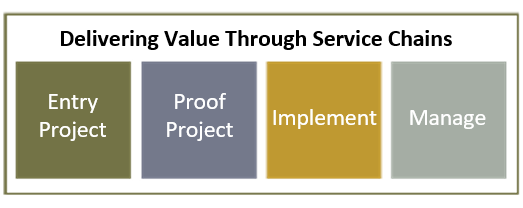This blog is part of a series on Service Chains. To read the first blog in the series, click here .
Entry Projects are the first step in a Service ChainSM. They start the client on their journey to realizing a solution by allowing them to understand the applicability of an Idea to their business. It should always be a paid engagement.
As the first paid engagement on the client’s journey toward the full solution, the Entry Project is critical. It must provide certainty that the Idea applies and warrants further investment to attain the benefits of the solution, thereby moving the client forward in their decision process. Execution of the Entry Project sets the tone and expectations for all the work to follow in the Service ChainSM.
Alternatively, an Entry Project may show that an Idea is not germane to a particular client. While not ideal from your perspective, if the Entry Project is well positioned and executed, the client still derives value from understanding the lack of applicability of the Idea and you retains the right to bring additional Ideas to the buyer in the future.
Entry Projects focus on proving applicability of an Idea to a client and making the case for action. Thus, they typically include some or all of the following components:
Verifying that the client is experiencing the particular issue, challenge, or problem that the overall solution is designed to address
- Confirming that a particular opportunity exists that the client could or should pursue
- Sizing the impact of addressing a problem or pursuing an opportunity, including: cost, benefit, level of effort, amount of disruptions
- Identifying or validating root causes
- Showcasing the advantages of your approach to the challenge or opportunity
- Planning for the solution
- Assessing resistance to the Idea and gaining buy-in from key stakeholders for the change required
To accomplish these objectives, Entry Projects can take many forms. Examples include:
- Ready Offers which can be sold in 1 or 2 meetings without extensive application of subject matter experts or delivery resources and are pre-priced and highly standardized: Executive Briefings, Planning Workshops, Mini-Assessments
- Tailored Offers which must be created for a client-specific situation and client-specific needs, and therefore, require more input from delivery resources and subject matter experts: Custom White Papers, Detailed Assessments
- Sense and Respond Offers which are defined through the selling process with significant involvement from subject matter experts to define a custom solution: Custom Assessments, Executive Working Sessions
The size, scope, speed, and cost of an Entry Project are critical elements to success. While specifics of those elements vary by industry, Idea, overall size and impact of the complete solution, authority of the buyer, and other factors, guiding principles include:
- Fees should be below the executive’s budgetary authority, but sufficient to attach importance to the effort for the executive and the organization
- Length and scope must include sufficient time to develop meaningful analysis, insight, relationships, etc. – it must maintain momentum for the full solution. Typically, the timeline is measured in days to weeks, not months
- Participation often includes key stakeholders for future purchase decisions and/or implementation considerations. This objective should be explicitly planned for and effective use of the Steering Committee can accomplish this goal
- It presents an excellent opportunity to expand relationships to other influencers within the organization to build rapport and credibility
- As you gather data and input, you often have the chance to expand your understanding of the client organization beyond simply the Entry Project scope, which can be very valuable to the account plan
- Deliverables must make the next steps (i.e., Proof Project) self-evident and create momentum for action
While mentioned earlier, we must emphasize that the buyer must write her first check for the Entry Project. All too often, our clients want to “give away” the Entry Project or bundle the fees into a discrete purchase of core products because they think it will make selling it easier – “once we are in the door and they begin to see value, we can start charging them.” This is a major mistake. Doing so fundamentally undermines the journey because it diminishes the buyer’s attention and commitment to the effort. If the idea is valuable, the buyer should and will be willing to make an explicit economic investment. If she is not willing to do so, then you should view this as a red flag indicating one of two things:
- The value of the idea has not been well positioned in the selling stages
- The buyer is not committed to achieving the outcomes
In either case, the risk of failure for both parties increases dramatically.
To read the next blog in this series, click here.
Written by: Doug Long
About the Author: Doug Long is a Partner with McMann & Ransford and has more than 26 years of experience in consulting across various industries, topics, and client challenges. Prior firms include Deloitte and GE. He currently leads our Healthcare Practice.

